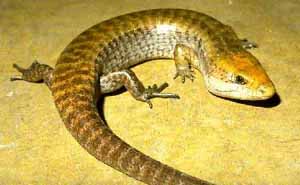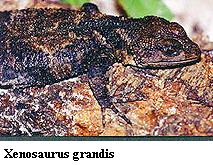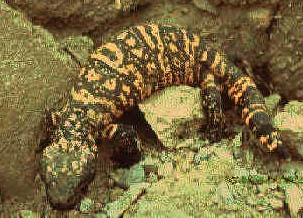Squamata: Scleroglossa
Taxa on This Page
- Anguimorpha
- Anguoidea
- Lanthanotidae
- Monstersauria
- Necrosauridae X
- Varanidae
- Varanoidea
Varanoidea
In retrospect, it might have been better to structure this area of phylospace on crown taxa: Anguimorpha = Anguis + Xenosaurus + Varanus and Varanoidea = Heloderma + Varanus. Then we could discuss Platynota = Varanus > Anguis, even if it isn't clear that anything lived in that region that wasn't already accounted for as a Varanoid, except perhaps Parviraptor. As matters currently stand, I have used Varanoidea = Varanus > Anguis which may leave the Xenosaurs outside Anguimorpha. That was not the intention. However, Nydam 2000) reminds us that the current best guess is that the xenosaurs and anguids are two separate branches from the tree. Nydam's phylogeny, based on Gao, GK & MA Norell (1998) can be abbreviated somewhat as follows:
If this is correct, which it likely is, the neat division of Anguimorpha into Varanoidea and Anguoidea falls apart -- Anguoidea is paraphyletic and includes Varanoidea. In addition, there is an ugly mess of unaffiliated species between the slimmed-down Necrosauridae and the varanids. For the moment, things will be left as they are; although a major overhaul seems inevitable.
It is interesting to reflect for a minute on what else was going on in vertebrate phylospace. Granted, the Cretaceous was a long, long Period -- about 80My. Still, there was clearly something significant going on in the last half of that Period which is a bit mysterious. Mammals were diversifying, if not really amounting to much, in the last part of the Cretaceous. But, they were comparative late-comers. The lizards and mosasaurs diversified and prospered, as did the dinosaur offshoot, the birds. In the non-tetrapod area, the modern sharks established their dominance, and the teleosts completed the transition from small tanks to swift, unarmored forms. Two different lineages of turtles learned to keep their heads in. The rest of the turtles disappeared. Modern macrostomate snakes probably appeared, although, like the mammals, they were not a big numerical success immediately. Even crocs did rather well in the Late Cretaceous, spawning a number of new aquatic and terrestrial forms.
It is not at all clear what caused this polyphyletic radiation, and it is still possible that we are simply being misled by the sheer length of the Cretaceous. Still, it is curious that, except for mammals, every type of vertebrate which would have a meaningful role in the Tertiary diversified and evolved essentially modern forms in the last half of the Cretaceous. Even mammals and birds may have begun their radiations before the KT event, although here the evidence is more equivocal.
Were the dinosaurs losing their grip? There is no real sign of it. Earlier reports of a sharp decline in dinosaur diversity in the Late Cretaceous seem to have been largely refuted. The very latest part of the Cretaceous record Maastrichian) is not well reflected in the geological record, so a decline could have occurred at this point. However, the events we are discussing mostly occurred over a longer period during which there is no doubt about the health of the dinosaur lineages.
What is more remarkable yet is that nothing like this has occurred since. After the end of the Cretaceous, the birds and mammals radiated strongly for about another 10-20 million years. But, by early or mid-Eocene times, almost all of the major types of both taxa had established themselves. Thus we have a major vertebrate turnover which seems to have taken about 50 My and affected essentially all vertebrate types. Before and after these periods, we see steady change but nothing quite as radical for quite some distance in either direction.
It would be easy to make too much of this and to get mired down in looking for a "cause." In fact, there is no reason to suppose that some major change in climate, vegetation, atmospheric composition or anything else caused the turnover. It is generally conceded that some cataclysmic event helped the process along at the KT boundary. However, faunal change was already well under way. The bolide or similar event probably prolonged and intensified the change, and may have weighed heavily in favor of mammals or birds and against non- avian dinosaurs. However, the most likely root cause for the entire process is random chance. Evolution is a non- equilibrium process. Life is sometimes metastable, or at some steady state. It is never at equilibrium. It should then require no more than the right local instability, produced by chance, to start a chain reaction which may take 50 My to damp out..
So, there is no need to find a cause for instability. The more interesting question is to explain the rest of vertebrate paleontology. Any reasonably complex non-equilibrium process is subject to these sorts of readjustments. The really strange thing is stability. That requires an explanation. ATW 010521
References: Caldwell 1999); Lee (1997a); Nydam 2000); Rieppel & Zahar (2000); Schultze (1994).
Descriptions
Range: Jurassic to Recent
Comment:Clade based on molecular phylogeny. Represents nearly 60% of extant squamates, including all venomous species and many related non-venomous species. Includes the following groups: Serpentes (snakes), Iguania and Anguimorpha, including Varanidae, Anguidae, and Helodermatidae (Gila monster and Mexican beaded lizard).
Links: Wikipedia
 Anguimorpha: Paravaranus?
Used here to mean the node Anguoidea + Varanoidea. However, the more conventional definition is the stem (Varanus + Anguis) > Scincus. Hopefully, these are almost exactly the same group, except perhaps for Paravaranus (in stem but not node). Paravaranus really ought to be Scleroglossa incertae sedis because it is so incompletely known.
Anguimorpha: Paravaranus?
Used here to mean the node Anguoidea + Varanoidea. However, the more conventional definition is the stem (Varanus + Anguis) > Scincus. Hopefully, these are almost exactly the same group, except perhaps for Paravaranus (in stem but not node). Paravaranus really ought to be Scleroglossa incertae sedis because it is so incompletely known.
from the Late Jurassic. Currently ~130 species of mostly predacious lizards worldwide, some very large.
Tongue in 2 parts, with notched, inelastic forepart separated by transverse fold from the elastic hind part, which serves as a sheath when the tongue is withdrawn; tongue thin & protrusible for at least 1 head length; teeth nearly solid, not hollowed at base, replaced alternately that is, new tooth comes up behind, not beneath, the older tooth); if body osteoderms present, scales are large, imbricate; body has lateral fold between axilla and groin.
Image: Diploglossus.
Links: Reptilian Systematics; Secondary structure .pdf.; Anguimorpha Mikko's Phylogeny); Anguimorpha; Volume 21 No. 1 abstract of Gauthier article on phylogeny); Digimorph - Shinisaurus crocodilurus (Chinese crocodile lizard) detailed scans of skull); Herpetology- Lizards brief discussion of included groups); 蛇蜥亚目 Chinese: looks like a great site!); Volume 21 No. 1 abstract of key phylogenetic paper); Molecular systematics of primary reptilian lineages and the ... ; Molecular Phylogenetics, tRNA Evolution, and Historical ... Macey et al., 1999: as discussed extensively elsewhere, Macey is one of the few who uses mitochondrial genome data in what we consider an appropriate manner), see also, Macey's vita, with additional publications; Kinematics of prey transport in lizards; The Excavations of Guimarota, Portugal anguimorphs at Guimarota!!?).
References: Macey et al. (1997) (not really relevant, but very interesting); Nydam 2000). ATW040709
 Anguoidea:
Xenosaurus, anguids, shinisaurs, etc. Quite likely not monophyletic as generally used. The working definition used here is Anguis > Varanus.
Anguoidea:
Xenosaurus, anguids, shinisaurs, etc. Quite likely not monophyletic as generally used. The working definition used here is Anguis > Varanus.
Characters: tooth replacement posterolingual, with small resorbtion pits; opening of Jacobson's organ separated from choana (neochoanate); less than 14 scleral ossicles; frontals fused; frontals constricted between orbits; jugal contacts squamosal on supratemporal arch; clavicle curves anteriorly; pubes long; pubic tubercle anteroventral; osteoderms present.
Links: Anguimorpha
References: Caldwell 1999); Lee (1997a). ATW030720.
 Varanoidea = Platynota)
Varanoidea = Platynota)
Defined here as Varanus > Xenosaurus which is probably the same as the Platynota of most authors.
from the Late Cretaceous, probably of Laurasian origin. Currently numerous species in Australia and Southern Asia, with 4 species in Africa and 2 in North America.
Very conservative morphology, but size ranges over 5 orders of magnitude; recurved teeth with posterior serrations; premaxillary teeth smaller than maxillary teeth; marginal teeth widely spaced; teeth plicidentinate; $ replacement teeth erupt posterolingual to functional teeth; mandible hinged in middle; $ maxilla does not reach posterior orbit; $ loose splenial - dentary contact; $ reduced contact between dentary and all post-dentary bones; extensive medial exposure of angular; foramina for Jacobson's organ separate from choana & enclosed by vomers & maxillae (neochoanate); $ ectopterygoids contact palatines; ectopterygoids expanded; frontals with descending processes located in middle & anterior region; hypoglossal (XII) and vagal (X) exits located very close to jugular foramen; carotid duct absent; cranial osteoderms fragmentary or absent; autotomy septa absent; clavicles rod-like or absent; epicoracoid cartilage does not contact meso- or suprascapular (huh?); short-term color changes absent; most are active hunters, some aquatic and arboreal; male combat dance.
Notes: The issue is whether the Varanoidea are big enough to contain the mosasaurs and snakes as Lee 1997a) argues. I have expressed my doubts elsewhere. As Caldwell (1999) argues, the recognition of Pythonomorpha does not require acceptance of Varanoidea as the root. The result depends strongly on the assumed homologies. See Rieppel & Zahar (2000), Schultze (1994). 010520.
Image: Skull of a monitor lizard. Bones in color are the dentary yellow), squamosal (red) and quadrate (green). Photo by Dr. R. G. Sprackland. Courtesy The Virtual Museum of Natural History.
Links: Eric Pianka's Varanid Research (phylogeny); Varanus Reference List (refs); Higher Reptile Taxa (taxonomy); Fossil Monitor Lizards origin); Warane (Einführung) German); Untitled Document; Bibliography for Heloderma (Gila Monster, Beaded Lizard); Platynota sensu Pepin, 199?, and Caldwell, 1999; Envenomation; Digimorph - Varanus gouldii (sand monitor); Volume 21 No. 1 abstract of a Gauthier revision of the Anguoids); Digimorph - Heloderma texana (fossil Gila monster).
References: Caldwell 1999); Lee (1997a); Nydam 2000); Rieppel & Zahar (2000); Schultze (1994). ATW030115.
 Monstersauria: venemous lizards, including Estesia (upK of Asia), Gobiderma upK of Mongolia), Heloderma (the Gila Monster, R of NAm), Lowesaurus (Oc of NAm), Paraderma (up?K of NAm), Primaderma mK of NAm), Telmasaurus?
Monstersauria: venemous lizards, including Estesia (upK of Asia), Gobiderma upK of Mongolia), Heloderma (the Gila Monster, R of NAm), Lowesaurus (Oc of NAm), Paraderma (up?K of NAm), Primaderma mK of NAm), Telmasaurus?
Range: fr mK.
venomous (probably not Primaderma); teeth strongly plicidentinate; 9-13 maxillary teeth; body of vomer rod-like; foramina for Jacobson's organ separate from choana & enclosed by vomers, maxillae & septomaxillae (not Heloderma?); palatines short; palatines toothed; large anterior processes of ectopterygoid covering palatine or pterygoid; ectopterygoid expanded and suborbital fenestra restricted; posterior end of maxilla does not reach mid-orbit (not Heloderma); coronoid with long anterior extension overlapping dentary; prefrontal contacts postfrontal (not Gobiderma); pineal foramen absent; supratemporal large; osteoderms present; fused, fragmented osteoderms on skull.
Links: Untitled Document; Monstersauria; Animal Diversity Web: Heloderma suspectum (Gila Monster): Narrative; Gila Monster (DesertUSA); Dr. Seward's Gila Monster Web; Gila Monster Printout- EnchantedLearning.com; Eric Pianka's Varanid Research.
References: Caldwell 1999); Lee (1997a); Nydam 2000).
Note: Many of these characters seem to be plesiomorphic for Varanoidea, if not more basal.. 011119.
 Varanidae:
Varanus
Varanidae:
Varanus
presently Old World tropics: Afr, Asia, Aus.
Phylogeny: Varanoidea ::Lanthanotidae + *.
medium to very large (6m); long, forked palatal process of premaxilla; palatal shelf on posterior maxilla; median ridge on ventral surface of vomers; no teeth on palatine or pterygoid; dorsal process of epipterygoid articulates with prootic; nasals do not contact prefrontals; descending processes of frontals meet medially; postfrontals absent; palpebrals absent; jugal very slender; postorbital bar incomplete; ribs absent of first 5 cervical vertebrae; 3 sternal ribs; long lateral arms of interclavicle; posterior emargination of coracoid; carpal intermedium absent; short pubis with short, ventrally-directed symphysial process; oviparous; carnivorous or insectivores; almost all terrestrial; use tails aggressively (in fact, they're just plain obnoxious and use everything aggressively); stylized male combat behaviors in upright position, balanced on tail.
Links: Varanidae; Animal Diversity Web: Family Varanidae; -= V. rudicollis -- Family Varanidae =-; Varanidae; Eric Pianka's Varanid Research; Where V. rudicollis comes to bask!; Fossil Monitor Lizards; Jennifer C. Ast's half-completed Science Page; Varanidae.
References: Caldwell 1999); Lee (1997a).
Image: Varanus exanthematicus, the Savannah monitor, from the Honolulu Zoo. ATW010921.
 Lanthanotidae:
Lanthanotus, the "earless monitor"; Cherminotus.
Lanthanotidae:
Lanthanotus, the "earless monitor"; Cherminotus.
1 extant species in Borneo, Lanthonotus borneensis.
30-45 cm, semiaquatic; broad palatal shelf of maxilla; ectopterygoid with distinct notch on lateral margin; ectopterygoid expanded and suborbital fenestra restricted; angular & splenial articulate with vertical articular face with lateral lappet from angular behind splenial; anterior of coronoid does not overlap dentary; nostrils are moved back and upwards (aquatic adaptation); internal nares very thin, slit-like; descending process of frontals posterior; tiny eyes with moveable lids (lower lid transparent); less than 14 scleral ossicles; orbital rims form prominent lateral bulges projecting well beyond cheek; prefrontal contacts postorbital bones above orbit; pineal foramen absent; posterior opening of vidian canal at suture of basisphenoid and prootic; no ear opening; supratemporal fenestra open & supratemporal arch absent; slender, elongated body; sternum with with only 2 pairs of ribs; sternum short & triangular; clavicle curves anteriorly; interclavicle cruciform with large anterior process; pubes long, with symphysis ventrally directed and pubic tubercle anteroventral; short limbs; reduced phalangeal count; heterogenous scalation with underlying osteoderms.
Links: Lanthanotidae; Øreløs varan - Dyrebrevkassen (Danish); Eric Pianka's Varanid Research
References: Caldwell 1999); Lee (1997a).
Image: Lanthanotus from Prof. Eric Pianka's Varanid Research.. 010520.
 Anguimorpha: Paravaranus?
Used here to mean the node Anguoidea + Varanoidea. However, the more conventional definition is the stem (Varanus + Anguis) > Scincus. Hopefully, these are almost exactly the same group, except perhaps for Paravaranus (in stem but not node). Paravaranus really ought to be Scleroglossa incertae sedis because it is so incompletely known.
Anguimorpha: Paravaranus?
Used here to mean the node Anguoidea + Varanoidea. However, the more conventional definition is the stem (Varanus + Anguis) > Scincus. Hopefully, these are almost exactly the same group, except perhaps for Paravaranus (in stem but not node). Paravaranus really ought to be Scleroglossa incertae sedis because it is so incompletely known.



